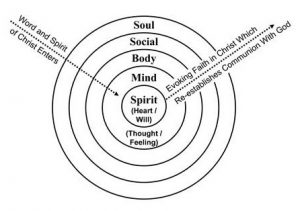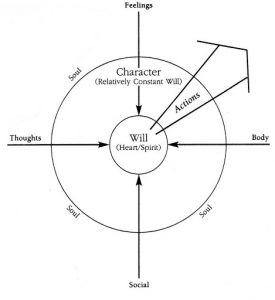Dallas’ Model of Human Beings
 In Renovation of the Heart, Dallas created a wonderful structural model of an individual who lives in a world of people and events and bodies and ideas. It shows the various layers that exist within each soul, all of which need attention and transformation in order to become the person God designed us to be.
In Renovation of the Heart, Dallas created a wonderful structural model of an individual who lives in a world of people and events and bodies and ideas. It shows the various layers that exist within each soul, all of which need attention and transformation in order to become the person God designed us to be.
However, Wilder treats this diagram as if it were a process model that is to be traversed in a linear fashion. Consequently, he determines that Dallas put “will” in the wrong place; that it needs to be moved further out in the diagram because it comes later in the process. That reflects a rather significant misunderstanding of what the model represents and how it might be helpful to us.
 We know this to be true, because Dallas himself lays out a diagram of how the will is subject to all sorts of influences, including thoughts, feelings, and relationships. That was Dallas’ process diagram, as opposed to his basic structural diagram of the person. (Images are from Renovation of the Heart.)
We know this to be true, because Dallas himself lays out a diagram of how the will is subject to all sorts of influences, including thoughts, feelings, and relationships. That was Dallas’ process diagram, as opposed to his basic structural diagram of the person. (Images are from Renovation of the Heart.)
The basic problem here is that Wilder simply fails to hear what it is that Dallas calls “will” and instead substitutes his own definition of will (something like stand-alone rational choice) and then proceeds to argue against a definition that Dallas did not propose. The will as Dallas conceives it does not reside in a part of our brain. Nor is it driven by thoughts and reason alone. In fact Dallas takes pains in the early chapters of the book to clarify the limits of the will. Any careful reading will reveal that Dallas placed it correctly in the center of his structural diagram.
Wilder wants to equate will with rational choice, which he then uses to support his argument that Dallas is teaching left-brain processes. However, Dallas has spoken at length about how rational choices are insufficient to live the way Jesus lived, and that there are other powerful factors involved besides rational thoughts which impact our will.
And as much as Wilder would like to locate choice in the slow-track, Antonio Damasio (Decartes Error) demonstrated rather conclusively that there is no such thing as purely rational conscious choice, and that all of our decisions include input from the right hemisphere. Our mind works as an integrated system, not as separate unrelated parts. Yes, we do have thoughts that are part of the process, but it is not the only factor in our “choices.”
The real issue here is whether or not our mind is well integrated. And that is one of the outcomes of engaging with God in spiritual practices.
Thank you for writing this! I have read Wilder’s book twice and scribbled many comments. Now I have been re-reading Renovation of the Heart a few more times trying to think of the best way to respond to Wilder’s book. For the most part you are voicing a lot of what I would write if I was a faster processor!
I like a lot of the contribution of Life Model to the practice of Spiritual Formation but think Wilder largely missed the point in a lot of Dallas Willard’s writings on the subject, at least in this book. There is so much that Willard wrote that speaks to the interaction of the fast track and slow track for Spiritual Formation but most of the best stuff seems to have been missed in Wilder’s analysis.
I too have trouble finding fault with much of anything Dallas wrote regarding spiritual formation. I have found the VIM approach to be very practical and helpful and life changing.